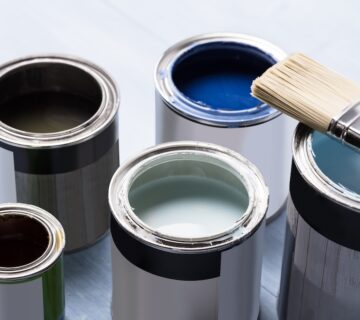Choosing the right paint for your home involves more than selecting a shade you find appealing. The type of paint you choose plays a pivotal role in both the visual impact and the durability of your paint job, affecting how long it will last and how it will stand up to daily life. In this blog, we delve into the essential factors you should consider to find the optimal paint selection for your unique home environment. We aim to help you navigate through the myriad of options to secure the best possible outcome for your space.
Consider the Room’s Function
Different rooms have distinct purposes, requiring specific paint qualities. Specialized paints that resist water and prevent mold growth are ideal for moisture-exposed areas like kitchens and bathrooms. Meanwhile, living rooms and bedrooms may experience less moisture but more wall contact, necessitating durable paint for regular cleaning. Matching paint types to room functions ensures longevity and aesthetic appeal. Choose paints tailored to each room’s needs for optimal performance and visual appeal.
Types of Paint: Oil-Based vs. Water-Based
When it comes to choosing between oil-based and water-based paints, each has its advantages and particular uses. Oil-based paints, revered for their durability and rich finish, are excellent for woodwork and trim. However, they emit strong fumes and require harsh chemicals for cleanup, making them less than ideal in poorly ventilated spaces. Meanwhile, water-based paints are user-friendly, emit a milder odor, and dry quickly, making them a common choice for interior walls.
Sheen Matters
The sheen of your paint is not just a stylistic choice; it affects the paint’s practicality as well. High-gloss finishes, favored for areas experiencing frequent use like door frames and kitchen walls, are resilient and easy to clean. However, these glossy surfaces can also show every little imperfection, so they’re not the best choice for older walls with a lot of wear. Matte paints, while less resilient, can hide those imperfections well but might require more touch-ups over time. Eggshell and satin are middle-ground options that provide a modest sheen while still being relatively easy to maintain.
Color Considerations
The color you paint your walls can alter the perception of a room’s size and shape. Light colors are known to open up a space, making small rooms feel larger and more inviting, while darker colors can create a cozy, intimate atmosphere in a larger room. The room’s lighting should also influence your color choice, as natural and artificial light can dramatically alter how a paint color looks at different times of the day. Always test a color in the actual room environment before making your final decision.
Eco-Friendly Options
Eco-friendly paints have become more popular as people become more conscious of the environmental and health impacts of traditional paints. These low or zero VOC (volatile organic compounds) options provide a safer alternative for indoor air quality and are less harmful to the environment. They are available in a wide range of colors and finishes, making it easier than ever to make a choice that’s good for both your home and the planet. Additionally, advances in eco-friendly paint technology mean that you no longer have to sacrifice quality for environmental benefits.
Durability and Maintenance
For high-traffic areas like children’s bedrooms or hallways, prioritize durable, washable paint. Modern paints formulated to resist scrubbing without losing their finish are especially beneficial for homes with young children or pets. Assess the activity level in the area and select paint accordingly. Investing in durable paint not only ensures longevity but also reduces the need for frequent repaints, ultimately saving time and money in the long run.
Primer is Key
A good primer serves as the foundation for a durable and even paint job. It not only helps paint adhere better to the surface but also increases the longevity of the paint and improves the overall look of the finish. In some cases, using primer can actually save paint because it reduces the number of coats needed for full coverage. Don’t skip the priming step, especially if you’re making a dramatic color change or painting over a darker shade.
Final Thoughts
Selecting the right paint for your home is a decision that should be made with care, considering not just the immediate aesthetic appeal but also the long-term practicalities. Think about the room’s purpose, the type of paint and sheen that will best suit your needs, the color that will enhance the space, and the environmental impact of your choice. Remember that a solid foundation with primer can make all the difference in the results. For more advice on selecting paints and home renovation tips, visit our website at sisupainting.com and check out our blog at sisupainting.com/blog.





No comment